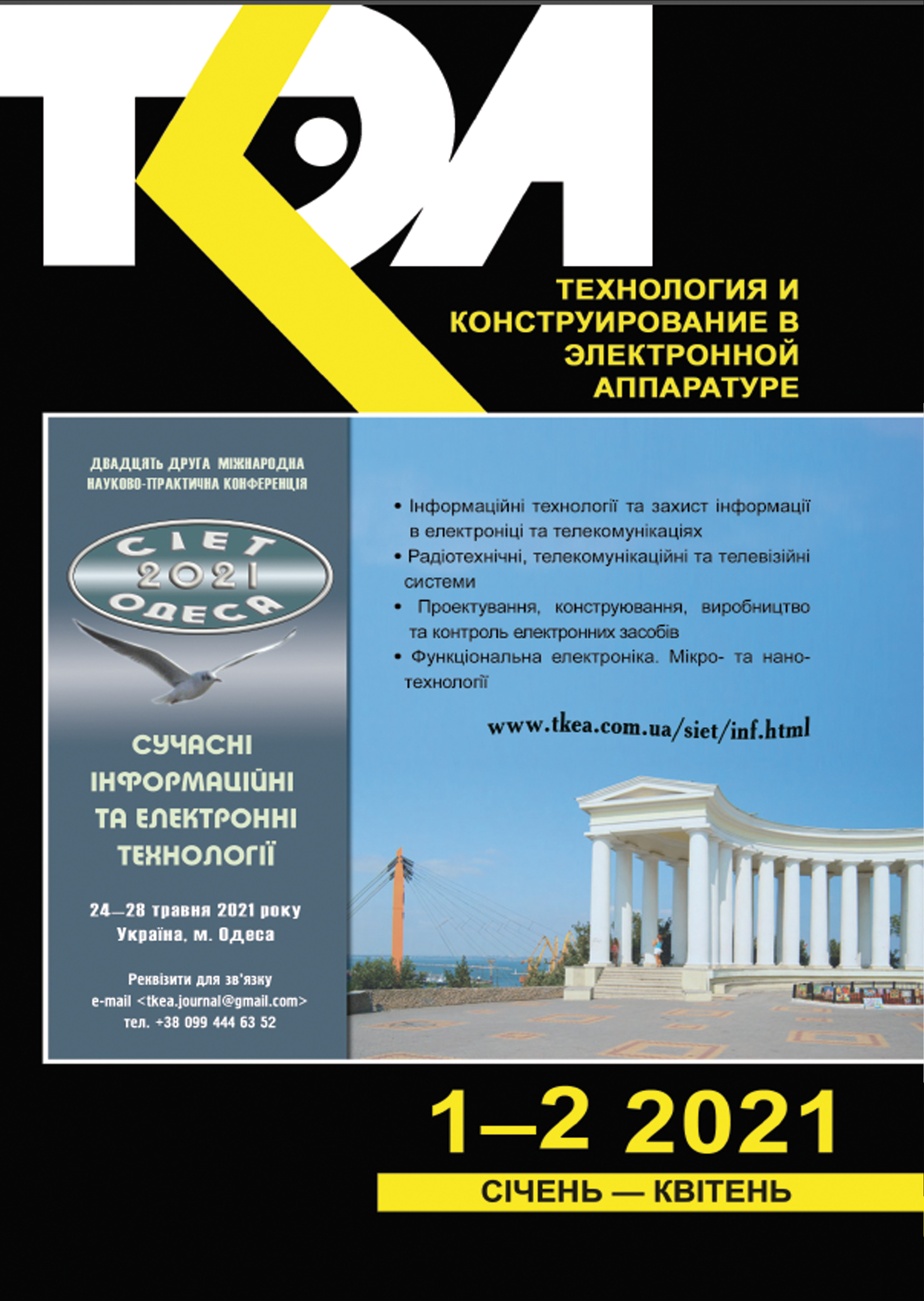Supercapacitor energy storage systems for lighting systems with combined power supply
Abstract
Modern continuous lighting systems use powerful high-performance LEDs as light sources and an important task is to begin using alternative renewable energy sources for their power supply (including during the day). The simplest of the renewable energy sources is photovoltaic solar energy converter. However, solar photovoltaic generation depends significantly on many factors — geographical location, time of day, state of the atmosphere, time of year and the like. In addition, photovoltaic generation depends on the weather conditions and cloudiness, which makes it unstable and prone to change drastically (by an order of magnitude) during daylight hours. Therefore, an important element of the power system based on renewable energy sources is the system of accumulation of generated energy. The method of power stabilization using supercapacitors for systems with a significant change in power generation in the electrical power system is analyzed. The paper offers design principles of the power supply systems for powerful LEDs with supercapacitor energy storage devices intended to make the use of energy from sources with variable generation more efficient. The systems with supercapacitor-based drives, which allow to ensure stable operation of the lighting system when the power supply from an alternative source is absent or reduced, provide high safety and reliability, and have a significantly longer service life than battery-based energy storage systems.
References
Pekur D.V., Sorokin V.M., Nikolaenko Yu.E. Experimental study of a compact cooling system with heat pipes for powerful LED matrix. Tekhnologiya i Konstruirovanie v Elektronnoi Apparature, 2020, no. 3-4, pp. 35-41. http://dx.doi.org/10.15222/TKEA2020.3-4.35 (Ukr)
Borkowski, P., Pawlowski M. Zasilanie energooszczednych zrodel swiatla poprzez systemy zasobnikowe. Przeglad Elektrotechniczny, 2013, vol. 89, N 1A, pp. 21-24.
Mamen A., Supatti U. A survey of hybrid energy storage systems applied for intermittent renewable energy systems. In Proc. of 2017 14th International Conference on electrical Engineering/Electronics, Computer, Telecommunications and Information Technology (ECTI-CON), 2017, pp. 729-732. https://doi.org/10.1109/ECTICon.2017.809634
Nikolaenko Yu.E. Kravets V.Yu., Naumova A.N., Baranyuk A.V. Development of the ways to increase the lighting energy efficiency of living space. International Journal of Energy for a Clean Environment, 2017, vol. 18, iss. 3, pp. 275-285. https://doi.org/10.1615/InterJEnerCleanEnv.2018021641
Kolomzarov Yu.V., Kostilov V.P., Sorokin V.M et al. Environmental issues of lighting and prospects of energy-saving LED lighting systems with combined power supply. Tekhnologiya i Konstruirovanie v Elektronnoi Apparature, 2020, no. 5-6, pp. 3-9. https://doi.org/10.15222/TKEA2020.5-6.03 (Ukr)
Kulova T.L., Nikolaev I.I., Fateev V.N., Aliev A.Sh. [Modern electrochemical energy storage systems]. Kimya Problemleri, 2018, N 1, pp. 9-34. (Rus)
Barton J.P., Infield D.G. Energy storage and its use with intermittent renewable energy. IEEE Transactions on Energy Conversion, 2004, vol. 19, N 2, pp. 441-448. https://doi.org/10.1109/TEC.2003.822305
Marlinda A.R., Zaman Zaira Chowdhury, Yasmin Binti Abdul Wahab et al. Chapter two - Fundamental electrochemical energy storage systems Suresh Sagadevan. Advances in Supercapacitor and Supercapattery, 2021, pp. 27-43. https://doi.org/10.1016/B978-0-12-819897-1.00001-X
Krishnamoorthy K., Pazhamalai P., Mariappan V.K et al. Two-Dimensional Siloxene-Graphene Heterostructure-Based High-Performance Supercapacitor for Capturing Regenerative Braking Energy in Electric Vehicles. Adv. Funct. Mater, 2020, Art. no. 2008422. https://doi.org/10.1002/adfm.202008422
Kozhushko Yu., Pavkovic D., Karbivska T., Safronov P., Bondarenko O. Robust Control of Battery-Supercapacitor Energy Storage System Using Kharitonov Theorem. In Proc. of 2020 IEEE 14th International Conference on Compatibility, Power Electronics and Power Engineering, CPE-POWERENG 2020, 2020, pp. 550-555. https://doi.org/10.1109/CPE-POWERENG48600.2020.9161569
Mars P. Supercapacitors for SSD backup power. Electron. Products, 2009, vol. 51, no. 10, pp. 40-41.
Miller J. R. Engineering electrochemical capacitor applications. Journal of Power Sources, 2016, vol. 326, pp. 726-735. https://doi.org/10.1016/j.jpowsour.2016.04.020
Kozhushko Y., Pavkovic D., Zinchenko D. et al. Hybrid Energy Storage System of Power Supply for Micro Resistance Welding. 2019 IEEE 39th International Conference on Electronics and Nanotechnology (ELNANO), Kyiv, Ukraine, 2019, pp. 584-589. https://doi.org/10.1109/ELNANO.2019.8783890
Arkhangelski J., Roncero-Sanchez P., Abdou-Tankari M. et al. Control and Restrictions of a Hybrid Renewable Energy System Connected to the Grid: A Battery and Supercapacitor Storage Case. Energies, 2019, vol. 12, iss. 14, art. no. 2776. https://doi.org/10.3390/en12142776
Tao Ma, Hongxing Yang, Lin Lu. Development of hybrid battery-supercapacitor energy storage for remote area renewable energy systems. Applied Energy, 2015, vol. 153, pp. 56-62. https://doi.org/10.1016/j.apenergy.2014.12.008
Kashkarov A. [Supercapacitor in an autonomous electrical circuit]. Sovremennaya elektronika, 2014, no. 1, pp. 38-40. (Rus)
Mouser Electronics. 2.7V 1F, 100F, 150F ULTRACAPACITOR CELL,. https://www.mouser.mx/datasheet/2/257/2_7_1_100_150F_ds_3001957_datasheet-1518704.pdf (28 December 2020).
Mouser Electronics. 3.0V 50F ULTRACAPACITOR CELL. https://www.mouser.com/datasheet/2/257/3V_50F_datasheet-1535527.pdf (28 December 2020).
Helmholtz H.V. Ueber einige Gesetze der Vertheilung elektrischer Strome in korperlichen Leitern mit Anwendung auf die thierisch-elektrischen Versuche. Ann. Phys. (Leipzig), 1853, vol. 165, iss. 6, pp. 211-233. https://doi.org/10.1002/andp.18531650603
Becker H.I. General electric. Low voltage electrolytic capactor. Pat. USA, no. 2800616, 1957.
Xing T., Ouyang Y., Zheng L. et al. Free-standing ternary metallic sulphides/Ni/C-nanofiber anodes for high-performance lithium-ion capacitors. Energy Chem, 2020, vol. 42, pp. 108-115. https://doi.org/10.1016/j.jechem.2019.06.002
An Y., Chen S., Zou M. et al. Improving anode performances of lithium-ion capacitors employing carbon-Si composites. Rare Met., 2019. vol. 38, pp. 1113-1123. https://doi.org/10.1007/s12598-019-01328-w
Chen Y., Qiu X., Fan L. Z. Nitrogen-rich hierarchically porous carbon foams as high-performance electrodes for lithium-based dual-ion capacitor. J. Energy Chem., 2020, vol. 48, pp. 187-194. https://doi.org/10.1016/j.jechem.2020.01.024
Zhao J., Burke A. Review on supercapacitors: Technologies and performance evaluation. Journal of Energy Chemistry, 2021, vol. 59, pp. 276-291. https://doi.org/10.1016/j.jechem.2020.11.013
Cree Inc. XLamp CMU Family LEDs,. https://www.cree.com/led-components/products/xlamp-cob-integrated-arrays/cmu-leds (28 December 2020).
NASA. NASA POWER Data Access Viewer. https://power.larc.nasa.gov/data-access-viewer/ (28 December 2020).
Copyright (c) 2021 Demyd Pekur, Yuriy Kolomzarov, Vitaliy Kostylyov, Viktor Sorokin, Vasyl Kornaga, Roman Korkishko, Yurii Nikolaenko

This work is licensed under a Creative Commons Attribution 4.0 International License.

